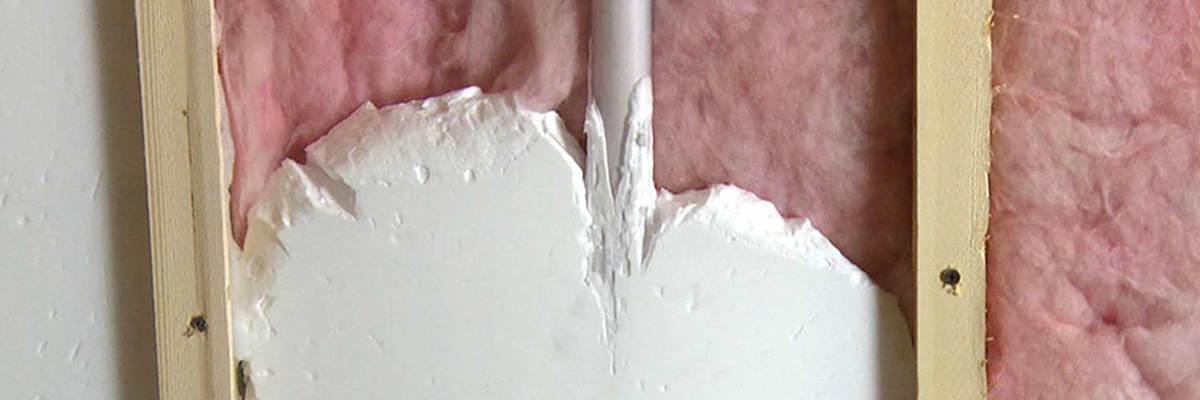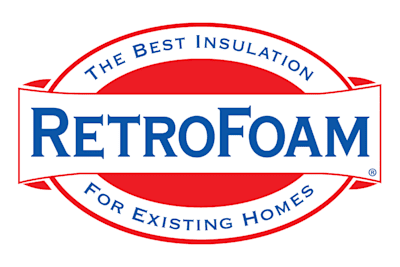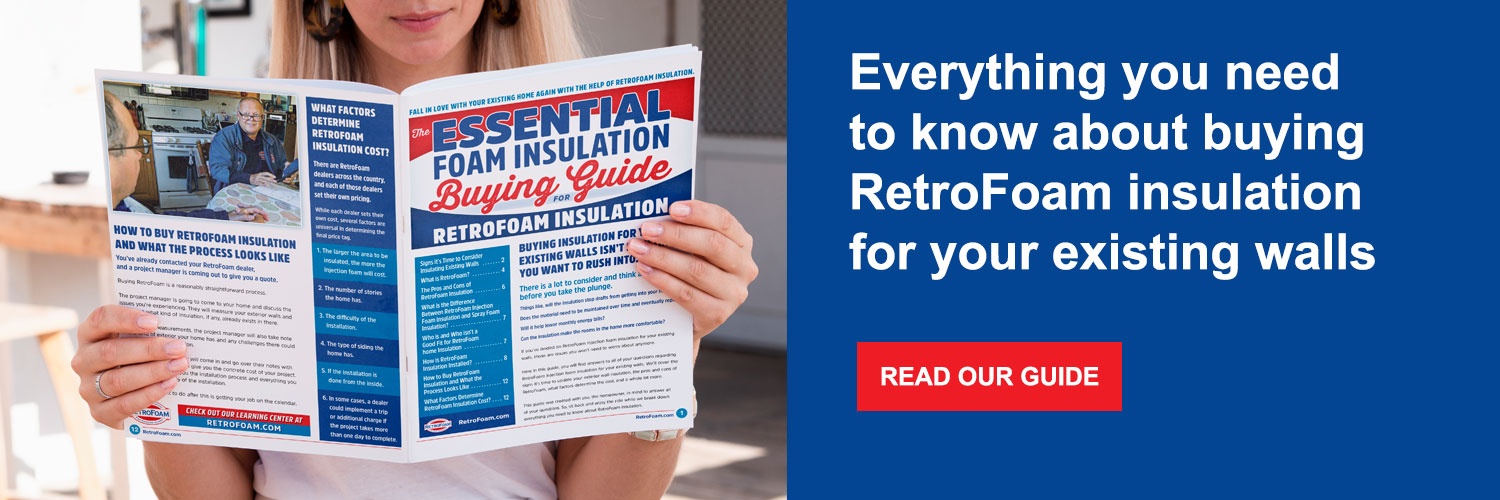What is RetroFoam Insulation?
injection foam insulation | RetroFoam insulation | existing wall insulation | FAQs


What is RetroFoam? (Quick Answer)
RetroFoam is a tripolymer based resin that creates an odor-free, non-toxic foam insulation. This injection foam doesn’t off-gas, is Class One Fire Rated, and safe to have in your home. It is an excellent fit for existing exterior walls and can be installed outside the home.
Now let's take a deep dive.
You know your exterior walls lack in the insulation department, so now you’re in the research phase of your insulation buying journey.
You’ve heard a lot about RetroFoam injection foam insulation, but you’re left wondering exactly what RetroFoam is.
Scouring the Internet, you’ve discovered something that has relieved your stress about your home’s comfort. Not only can your existing walls be re-insulated, but it can also be done without tearing down the drywall. You’ve found the answer, and it’s RetroFoam injection foam insulation.
But what is RetroFoam, and how does it work?
Don’t worry. We’re here to help.
We want to offer homeowners all of the information they need to make an informed decision about their home’s comfort and energy efficiency. This article will explain what RetroFoam insulation is, what it’s made of, and how it works.
What is RetroFoam Insulation?
RetroFoam home insulation is an injection foam insulation used to create an air seal inside existing exterior walls and concrete block walls.
When it comes to foam insulation, there might be some confusion as some insulation contractors use the term “spray foam” to describe injection foam. Both of these foam products are great for sealing the building envelope of a home but are installed differently, and it’s pretty clear by their names.
Spray foam insulation is sprayed into open cavities like attics, crawl spaces, rim joists, basements, or the exposed walls of a pole barn or commercial building. Injection foam, like RetroFoam insulation, is installed from the outside of the home into the existing exterior walls.
Now that we cleared up, here are some quick, basic facts about RetroFoam injection foam insulation.
RetroFoam is Class One Fire Rated, which means if there were a fire in your home, it wouldn’t act as a catalyst. It’s also important to note here that once a flame is removed, the foam will self-extinguish.
What is RetroFoam Made Of?
RetroFoam is a tripolymer based resin that creates an odor-free, non-toxic foam insulation.
The resin is mixed with a foaming agent and water in the contractor’s trailer, where the mixture creates the RetroFoam product. Once it’s mixed, the final product looks and has the consistency of shaving cream.
This consistency helps the RetroFoam insulation fill the cavity as it spreads around wires and pipes present in the walls.
How Does RetroFoam Insulation Work?
RetroFoam injection foam is insulation that creates an air seal.
This means the insulation will seal enclosed cavities, like existing walls, against air movement.
Unlike traditional insulation, injection foam never loses its shape like cellulose and fiberglass are known to do. It won’t settle, compress, shift, or sag over time.
Injection foam completely fills the cavity, getting into all of the nooks and crannies in the wall.
The insulation you have in your home should keep the temperature consistent without your air conditioner or furnace running constantly. That’s how the air seal that injection foam creates helps keep your monthly energy bills down while keeping your home comfortable.
When insulation is doing its job, it affects the conduction (heat transfer) and the convection (airflow), which are huge factors in the energy efficiency of your home as well as the comfort.
RetroFoam creates an air seal that reduces air leakage but also provides heat resistance.
RetroFoam Home Insulation Installation Process
You don’t have to worry about tearing your drywall down or ripping your home apart when installing RetroFoam home insulation.
Injection foam can be installed from outside your home. If your home has old fiberglass, it doesn’t need to be removed before installation.
If loose cellulose is in the wall cavities, crews will remove as much of that material as possible before injecting the foam.
The process changes slightly depending on the type of siding your home has.
A home with aluminum or vinyl siding will have a piece of that siding removed all around the house. A hole is then drilled into each stud cavity, and the RetroFoam is injected into the cavity. Once the cavity is full, the holes are plugged, and the siding is replaced.
For a home with a brick exterior, small holes are drilled through the mortar joints between every stud to inject the foam. Once the cavities are full, the holes are re-mortared.
Lastly, a home with wood siding has a slightly different process. If the siding can be easily removed, the same process for aluminum and vinyl siding is followed. If the siding can’t be removed, crews must drill holes through the siding to inject the foam. Once the cavities are filled, the holes are closed with wooden plugs.
Benefits of RetroFoam Insulation
RetroFoam injection foam insulation has a lot of benefits it adds to existing homes.
Many homeowners have said their homes are more comfortable, and they’re paying less in heating and cooling costs. These are great benefits, but there’s even more the material has to offer.
- RetroFoam creates an air seal that stops air leakage through the walls.
- Injection foam in the exterior walls can keep allergens and pollutants out of the home.
- A bonus benefit of RetroFoam is that it can reduce outdoor noise, making the home quieter.
- RetroFoam injection foam can pay you back over time from the money you save on monthly energy bills.
How Much Does RetroFoam Insulation Cost?
There’s a lot to consider when discussing the cost of RetroFoam injection foam insulation.
Each of our RetroFoam dealers set their own prices, so the best bet would be to request an estimate from your local dealer. However, we can give you an idea of all the factors that determine the final cost.
Of course, there’s the initial cost of the insulation, but what factors determine that cost? Not only that, but how can the energy efficiency of the material pay you back?
When you’re comparing prices for exterior wall insulation, RetroFoam will be the more expensive option. It’s a more expensive material because it quite frankly performs better than traditional insulation. A real bonus is that despite the cost, RetroFoam requires less of a headache during installation since the house doesn’t have to be gutted to the studs to install it, and that can be worth the cost.
Another factor is the size of your project. That’s why seeing the project in person can be really important when giving a price. A few things an insulation contractor will look at are the square footage and the installation’s difficulty. These are both things that can add to the final price of your RetroFoam insulation.
Where you live can also play a role in cost.
Think of it like gas prices. You might pay more for gas in a major city compared to what you pay in a rural area. It all comes down to the seller in that area determining the price. The same is true for RetroFoam dealers as they set their prices locally.
We talked about the money that comes out of your pocket, but what about the money that goes back into it?
Stopping air leaks into and out of your home will improve your energy efficiency. This means your home will maintain a constant temperature, and you won’t have to keep shelling out money to your energy provider to be comfortable.
The amount of money saved on monthly energy bills could eventually pay for the RetroFoam insulation.
RetroFoam Home Insulation Problems
Mistakes and accidents can happen, but the way an insulation contractor handles it says a lot about their business.
The problems that arise from RetroFoam don’t happen that often and aren’t material-based, so much as installation-based.
- Too much pressure during installation could cause the drywall to crack or bow and paneling nails to pop.
- The wall cavity may not be completely filled during the installation.
On the upside, these issues are rare. RetroFoam installers are specially trained on how to install the product the right way.
History of RetroFoam Injection Foam Insulation
In the early 1980s, Polymaster, the parent company of RetroFoam, started a business manufacturing foam insulation.
This new product was different from the foam insulation created by companies in the past because it was a low-formaldehyde product.
For nearly 20 years, Polymaster set the industry standard when it came to its foam insulation R-Value. In 2002, Polymaster’s InsulThane was one of the first polyurethane foam products on the market that was Zero Ozone Depletion Potential (ODP).
That same year Polymaster introduced its premium residential foam product RetroFoam.
RetroFoam Dealer Network
RetroFoam has dealers across the U.S. in 25 states, as well as in two other countries.
The manufacturer trains each dealer on the best ways to install RetroFoam home insulation. As part of the dealership start-up, the dealer is provided with state-of-the-art equipment, as well as expert training and marketing tools to help their customers.
The company also helps network the dealers together, so people who are new to the business always have an experienced person to reach out to.
If you’d like to find your local RetroFoam dealer, check out the Dealer Finder page on our website.
Related Articles
What is the Difference Between RetroFoam Injection Foam and Spray Foam Insulation?
How Do RetroFoam Installers Know the Cavity is Full When Insulating Existing Walls?
How Much Can RetroFoam Insulation Help Me Save on Energy Bills?
About Amanda Emery
Amanda previously has worked as a breaking news and crime reporter, TV news producer, and editor. As a journalist, she has won several awards from The Society of Professional Journalists - Detroit Chapter and the Michigan Press Association. Amanda uses her experience as a journalist to write content that will help educate homeowners on foam insulation benefits. When Amanda isn’t writing, she’s spending time with her husband Chris, daughter Lilith-Maeve, and rescued huskies Danger and Wendigo. She also loves knitting, making art, and cooking.


